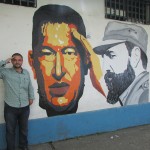 Almost a year has passed since the death of Hugo Chávez on March 5, 2013. Arguably this has been the most difficult one for the Bolivarian Revolution. Many people, both on the left and the right expressed doubt that there could be Chavismo without Chávez. Perhaps a year is still too short of a period to assess the situation after Chávez’s passing. Yet, the dynamic developments over the past twelve months call for some preliminary remarks. Through an analysis of the key events during the year, this piece advances the argument that despite the ongoing violent protest in Venezuela, the left has emerged stronger out of the crisis precipitated by the death of Chávez. In addition, the new president Nicolás Maduro has reconnected with his base and has shown a unique style and vision that have earned him admiration from his supporters and contempt from the opposition.
Almost a year has passed since the death of Hugo Chávez on March 5, 2013. Arguably this has been the most difficult one for the Bolivarian Revolution. Many people, both on the left and the right expressed doubt that there could be Chavismo without Chávez. Perhaps a year is still too short of a period to assess the situation after Chávez’s passing. Yet, the dynamic developments over the past twelve months call for some preliminary remarks. Through an analysis of the key events during the year, this piece advances the argument that despite the ongoing violent protest in Venezuela, the left has emerged stronger out of the crisis precipitated by the death of Chávez. In addition, the new president Nicolás Maduro has reconnected with his base and has shown a unique style and vision that have earned him admiration from his supporters and contempt from the opposition.
The crisis caused by Chávez’s death was first felt during the special elections to replace him on April 14, 2013. Although many expected that a sympathy vote would send Nicolás Maduro to the presidency with a wide margin, he came only 1.5 percent ahead of his right-wing rival Henrique Capriles. Although it is not unusual for a political party to win with a thin margin, the outcome was not typical for Chavismo. The election result can be explained in several ways.
First, it showed that indeed there was a significant section of the movement that voted for Chávez himself and after his passing found it difficult to cast a ballot for anybody else. Second, a combination of gloominess, as well as a dose of overconfidence on the part of Maduro’s campaign that sympathy alone would be enough to bring people to the voting booths also contributed to the weak result. Third, the tactic of the opposition was fruitful. Capriles struck both a more conciliatory and social democratic stance. He stated multiple times that “Maduro is not Chávez.” Thus he recognized Chávez as a skillful leader but argued that he cannot be replaced, by a lackluster candidate such as Maduro. Capriles also promised to keep the widely popular anti-poverty, healthcare, educational and housing Bolivarian social missions (misiones) instituted by Chávez’s government and even promised to improve them.
On April 14, 2013 Nicolás Maduro won the elections, but the opposition did not recognize the result and called for protests against the government. Besides burning tires, engaging in sabotage and attacks on public property, opposition thugs also shot dead eleven government supporters and wounded many throughout the country. On April 15 2013, three people died in Caracas Metropolitan Area, one in Sucre, two in Tachira and three in Zulia. The murders were particularly vicious and bore the signs of a revenge killings. For instance, Henry Rangel La Rosa “suffered from five shotgun wounds in his back” after attending a celebration on the occasion of Maduro’s victory.[i] The attacks were not limited to supporters of Partido Socialista Unido de Venezuela (PSUV). The opposition torched and vandalized fifteen health clinics in poor barrios across the country. The clinics are a part of the Barrio Adentro social mission, which places 30,000 Cuban doctors, dentists and sports trainers in the poorest neighborhoods free of charge. In addition to the health clinics, a number of communal media outlets and PSUV headquarters were also attacked. Capriles came under scrutiny because after the elections he called on his supporters to “drain their rage.”[ii]
After the violence subsided the opposition shifted its energy to criticisms of the government’s economic policies duly echoed by western media. Venezuela has seen some shortages and a high rate of inflation (56% for 2013). The opposition blames the government’s price and currency controls for these problems. Business owners claim that because they cannot obtain dollars, they have to get them on the black market at a higher unofficial rate. According to them, this situation forces them to charge for their goods prices that are determined by the unofficial rate, thus increasing the price on goods sometimes as high as tenfold. However, the government blames the shortages and high prices on speculation and hoarding aimed at sabotaging the state. Thus in November, 2013, after president Maduro received special powers from the national assembly to rule by decree, he went on the offensive and ordered shops around the country to cut their prices by more than a half. He also extended the list of goods under price control.[iii]
Of course, Maduro did not wait for the “parasitic bourgeois managers,” as he calls them, to follow the new law and sent in the National Guard to enforce it. The action resulted in uncovering large quantities of stockpiled goods and it brought prices down. Long queues formed in front of stores as people rushed in to purchase significantly discounted white goods, such as laundry machines, television sets and stoves.
This action demonstrated that Maduro is not afraid to confront capital and the opposition and people on the left saw him as a capable and strong leader. In contrast, the opposition perceived him as weak and its major strategy for the December 2013 municipal elections was to turn them into a referendum on his rule. In this way, the opposition continued the cycle of hypocrisy and self-contradiction. Despite the fact that for months it denounced the “corrupt” and “fraudulent” electoral system, the opposition did not find it hypocritical to call on its supporters to vote en masse during the municipal elections in December. “Plebiscite” and “referendum” were the most frequently used terms by the opposition during the electoral campaign.[iv] Essentially, in this way Capriles’ supporters turned the municipal elections into a national choice between a country with or without Maduro. However, this approach backfired.
On December 8, 2013, the PSUV and its allies won 242 mayoral races while the opposition party Mesa de la Unidad Democrática (MUD) managed to gain only 75. This meant that 73 percent of the elected mayors were Chavista candidates. The popular vote made a mockery of the opposition’s “plesbiscito” approach. 5.277,491 votes went for the pro-government candidates and 4.423,897 for MUD. In other words, if this was a referendum, 54 percent voted for Maduro while 44 percent cast a ballot for the opposition (2 percent voted for third candidates).[v] Unsurprisingly, on the next day the words “referendum” and “plebiscite” had completely vanished from the opposition’s dictionary.
But the elections proved that Maduro had reconnected with his base and was capable of a resounding win against the opposition. Even more importantly, it showed that beneath the candidates and the personalities, there are organized bodies that drive the revolutionary process, or “el proceso” as it is widely referred to in Venezuela. It showed that beyond the media personalities, whether Chávez or Maduro, there is a constellation of grassroots formations, such as communal councils, communes, communal media, cooperatives and occupied factories that can mobilize the revolution’s electoral victories from below. This is not to say that the role of the state or the leader are miniscule. Far from it. But what is clear is that underneath the traditional media narratives there exists a complex set of relationships that reinforces the Bolivarian Revolution even under a new leadership and during the deep crisis produced by Chávez’s physical absence.[vi] Perhaps this realization is what terrified the opposition.
But this should not be a reason to underestimate the unique features of the new populist leadership. Following the elections in December, Maduro’s personal vision and style also gained recognition by the opposition and the international media. All of a sudden the rhetoric shifted from “he is not Chávez” to he is “Chávez II” and even “much worse than Chávez.”[vii] This rhetoric revealed that the opposition realized that Maduro is capable of leading Chavismo. As a matter of fact, perhaps for this very reason, prominent opposition figures such as Teodoro Petkoff started to use the term “Chavomadurismo.”
The two factors—the grassroots as a driving motor of the Bolivarian Revolution and the capabilities of the new leadership—led sectors of the opposition to come to the conclusion that elections would not halt the political advance of the left. Thus in February burning tires, blocked highways and political murders returned to Venezuela. But this time the opposition was led by its ultra-right section and its most prominent personality Leopoldo Lopez—an active participant in the 2002 coup d’etat against Chávez and a former mayor of Caracas’ affluent district of Chacao.
This signaled a change in the opposition, part of which saw Capriles as too moderate. Indeed it is to deny that after the violence in April, Capriles’ strategy became more restrained. In January, he even shook Maduro’s hand in public after they discussed a common strategy to fight crime. This led some opposition media to speculate that his meeting with the Pope in November softened the “Miranda pitbull.”[viii] But this new approach coupled with his belief in building the movement through electoral campaigning did not resonate with the extreme section of the opposition. Thus under the hashtag #la salida or “The Exit” Leopoldo Lopez called on the opposition to go on the streets until the government “exits.” Apparently, the “referendum” result of less than two months ago has been forgotten. At the time of writing ten people have died in the clashes provoked by Lopez’s supporters. One of the most recent victims is the journalist Alexis Martinez, a brother of a ruling Socialist Party legislator.[ix] On February 18th armed opposition groups attacked a textile cooperative in the opposition stronghold of Los Cortijos and killed one worker.[x] On the first day of the protests, an opposition group assassinated a prominent leader from the radical 23 de Enero neighborhood of Caracas—Juan “Juancho” Montoya. Unfortunately, western media has remained silent about these and other cases of violence against government supporters.[xi] At the same time it exploded with the news of the death of Venezuelan student protester and beauty queen Genesis Carmona.[xii]
The prejudiced treatment of Venezuelan politics in western media is also evident in the fact that virtually every piece of news mentions violence, shortages of basic goods and inflation as an explanation for the unrest in Venezuela. Indeed, these are not unimportant issues, but why not unemployment, or poverty levels, or access to healthcare and education? Very few media outlets mention that in thirteen years (from 1999-2012) the Venezuelan government reduced poverty from 42.8 percent of the households to 26.7 percent, in another words, a 37.6 percent decline in the poverty rate. Extreme poverty declined even more, from 16.6 percent to 7.0 from 1999 to 2011 – a 57.8 percent decline.[xiii] And this is only one achievement of the revolution out of many which are deliberately ignored by the vast majority of western media. Instead, media as diverse as the Guardian and FoxNews seem to believe that Venezuela exists only when the right is protesting.
In many ways the current protests are nothing new.[xiv] Political violence remains a problem not only in the cities but also in the rural areas. After Chávez’s land reform, rights groups estimate that over 310 campesinos were killed in disputes with large landowners.[xv] But the current situation reveals a recognition by the opposition of Maduro’s strength. This supposedly pale imitation of Chávez is now a formidable enemy with his own style and vision that has “earned” him the opposition’s contempt.
Additionally, the uniform and uncritical coverage of the situation in western media conceals a split within the opposition.[xvi] After the violent protests on February 12, Capriles expressed concern that these actions were a step back. The split is visible in some opposition media as well. The popular English-language blog, Caracas Chronicles, which interestingly describes itself as “the place for opposition-leaning-but-not insane analysis of the Venezuelan scene”[xvii] included a piece that criticized Leopoldo Lopez’s actions, publishing a photograph of him during a protest with the caption “may be exposure to teargas causes learning difficulties.”[xviii] The author concluded that “middle class protests in middle class areas on middle class themes by middle class people are not a challenge to the Chavista power system, they’re part of the Chavista power system.”[xix] Even the Miami-based WLRN argued that Lopez might be “a rock star among Venezuelans in South Florida. But in west Caracas he’s the rich guy.”[xx] Last but not least, a Wikileaks cable revealed that the political counselor to the US embassy in Caracas, noted in 2009 that Lopez is a “divisive figure within the opposition” and is perceived by some as “arrogant, vindictive, and power-hungry.”[xxi] In other words, although there is momentum behind Lopez, his image is far from unproblematic for the opposition.
Lopez’s image, however has resonated well with the student movement. A poster in front of the University of Los Andes reads “A President without studies will never understand the students”, a reference to Maduro’s background as a bus driver and a union leader. It is little wonder that the students prefer Lopez; he was “born into a well-off family with links to the business and oil sector” and “has a master’s degree from Harvard University.”[xxii] The classist and racist elements in the student movement are a reason why Chilean students of the University of Chile, Chile’s largest university distanced themselves from their Venezuelan counterparts. In recent years Chile has seen enormous student protests. However, they were quick to state that “we do not feel represented by the actions of some Venezuelan students who have placed themselves on the side of defending the old order and are opposed to the change that the people support.”[xxiii]
In sum, the year after Chávez’s death has been difficult for the Bolivarian Revolution. Nevertheless, president Maduro reconnected with his base and earned the contempt of the opposition. The current violent protests in wealthy areas of the country are a serious challenge to the government. But anybody who visits a working-class neighborhood in Venezuela, as I did in December as a part of solidarity brigade, will understand that for the majority of Venezuelans there is no return to the pre-Chávez era.
Before the elections a worker at a chocolate cooperative told me a story of a debate he had with a friend of his from the opposition. Proudly, he recounted how he won the argument after insisting that his friend answer the question “So what do you propose?” Indeed this anecdote demonstrates how Chavismo has cornered the opposition and burning tires in upper-class areas of Caracas is not a substitute for sound argument. In contrast, Chavistas view themselves as a political subject and a protagonist of history. A woman from a barrio in the Petare area of Caracas explained to me that soap operas are dangerous because in the past they kept her glued to the television screen. But now she was an organizer and an active participant in her communal council. Another woman expressed the same sentiment and when somebody insisted that she probably watches at least a little bit of soap operas she reacted as if she was accused in relapsing into heroin addiction. The commitment to the process is expressed in multiple forms.
Many swear that they will continue Chávez’s project through a continuous support for his successor Maduro and the PSUV. Others, although committed to the Bolivarian Revolution are critical of the government. At the radical 23 de Enero neighborhood, which features a square and a bust dedicated to Manuel Marulanda, the long-term leader of the FARC guerillas, some activists called for a struggle against bureaucratization and a radicalization of the government. A female activist from a political movement within the PSUV, but critical of some trends in the party, insisted that the government should both give more autonomy to the grassroots organizations and let these organizations have more say in the party and state institutions. She reminded us that during the coup d’état against Chávez it was precisely the grassroots that stayed on the street and fought the forces of reaction while the officials of the ousted government were in hiding. Similarly, at a nationalized factory for oil, margarine and mayonnaise in the city of Valencia, a worker described the relationship between factory and the government through putting his clenched fists against each other. Through this gesture he explained that the relationship is one of friction but they move ahead together as one whole. Only a few months before this conversation the worker’s council successfully ousted a new manager appointed by the government. The moment was tense and the situation improved only after Nicolás Maduro interfered personally and appointed a new manager. All these critical voices indicate that the relationship between the state and the myriad of grassroots formations is not always smooth. But even these people agree that there is no return to the pre-Chávez era.
Today, this determination clashes, quite literally, with the opposition and its reactionary call for an “exit.” The question is how long can a government which struggles to rein in inflation and achieve food sovereignty tolerate these cycles of violence and sabotage initiated by the right. This is not only a question that pertains to the government and its repressive institutions but also to its supporters. Here it is worth recalling Hugo Chávez’ statement that “we are peaceful people, but we are not unarmed.” Whether the opposition is willing to continue the chaos and violence in order to provoke a strong response from the state remains to be seen. How these dynamics within the opposition and the government and between both forces will develop will be key in deciding whether Venezuela will solve its problems without violence.
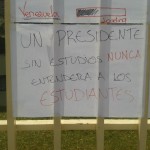
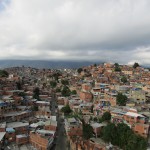
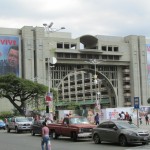
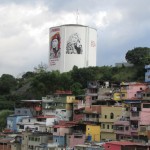
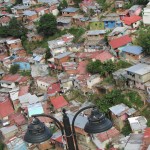
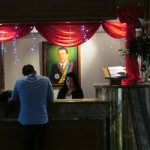
[i] From the Non-recognition of the Election Results to Fascist Violence in Venezuela, (Caracas, Venezuela, Ministry of People’s Power for Foreign Affairs, 2013), p.38
[ii] From the Non-recognition, p.7.
[iii] http://www.theguardian.com/world/2013/nov/20/nicolas-maduro-powers-venezuelan-economy
[iv] http://internacional.elpais.com/internacional/2013/12/04/actualidad/1386186413_709721.html
[v] http://www.cne.gob.ve/web/sala_prensa/noticia_detallada.php?id=3282
[vi] For an analysis on the interaction between the grassroots and the state see George Ciccariello-Maher, We Created Chavez: A People’s History of the Venezuelan Revolution, (Durham: Duke University Press, 2013).
[vii] http://www.teinteresa.es/mundo/Maduro-Chavez-peor-venezuela_0_1088292470.html#sr=g&m=o&cp=or&ct=-tmc&st=(opu%20qspwjefe)&ts=1393002487
[viii] http://caracaschronicles.com/2014/02/18/is-capriles-following-pope-francis-advice/
[ix] http://www.reuters.com/article/2014/02/21/us-venezuela-protests-idUSBREA1J1BX20140221
[x] http://aporrea.org/oposicion/n245448.html
[xi] For the most recent report in English on the deaths see http://venezuelanalysis.com/news/10382
[xii] http://www.nydailynews.com/news/world/venezuelan-beauty-quee-fatally-shot-head-protest-article-1.1620304
[xiii] http://www.cepr.net/documents/publications/venezuela-2012-09.pdf
[xiv] http://venezuelanalysis.com/analysis/10376
[xv] http://links.org.au/node/3669
[xvi] http://www.breitbart.com/InstaBlog/2014/02/20/Madonna-Bashes-Maduro-on-Instagram
[xvii] http://caracaschronicles.com/about/ This description clearly implies that there is an “insane” side of the opposition.
[xviii] http://caracaschronicles.com/2014/02/17/34988/
[xix] http://caracaschronicles.com/2014/02/17/34988/
[xx] http://wlrn.org/post/venezuelas-west-side-story-why-street-protests-arent-likely-topple-regime
[xxi] http://www.bbc.co.uk/news/world-latin-america-26238612
[xxii] http://www.bbc.co.uk/news/world-latin-america-26238612
[xxiii] https://www.greenleft.org.au/node/55906
de/55906


6 replies on “Venezuela: A Year after Chávez”
There have been hundreds of thousands of people in the streets on the opposition’s side. Probably most of them very dangerous and armed, burning tires (wow!) and so on … Get serious.
Yes, it is a pitty that the opposition employs such tactics, but it is time for Maduro to show diplomacy and empathy, not just force. The more he will make such remarks that people in the streets are nothing but a bunch of neonazis, bourgeois, class racists, the more the moderates will feel hate and contempt and they will be more determined to really fight the government and become really radical. And they will get all the simpathy they need from outside.
Where I live, in Britain, I think there is widespread recognition of some of the achievements of Chavismo in terms of redistribution of resources. However there is scepticism about the ability of the Venezuelan economy to be more than a supplier of oil to the world economy. To his/her credit, the author does mention how some activists are dissatisfied with the bureaucratic obstruction of popular initiatives and bodies. The model of industrial relations which seems to be followed is a corporatist one – with government, employers and unions trying to agree on common objectives. Capital will always try to sabotage such governance – with investment strikes, speculation etc. – because that is the nature of capital – to seek its self-expansion without regard to people. Things will come to a head – if they haven’t already.
I saw a recent report (ironically enough, on RT) where an academic sympathetic to Chavismo said he thought a coup was unlikely because the military is now loyal to the Bolivarian institutions. That is an interesting point which suggests that another Chile may not be on the cards after all. At the same time, what does it say about those Bolivarian institutions themselves, the bureaucracy which runs the country day to day? I am not sure but I would not be surprised if many of these bureaucrats are like bureaucrats everywhere – careerist officials for whom popular accountability is a threat.
If the Bolivarians are not as corrupt as the western media claim they are, if there are true revolutionaries among them and if they haven’t entirely co-opted the popular committees, then there is hope that pressure from below will drive a revolutionary process in the direction of more popular participation and direction of the economy and society. As the author remarked, there are other social forces like the Chilean students who are also expressing radical sentiments and who could be allies in such a process of refoundation of socialist practice.
Thank you for this comment. I think that you capture some of the most important issues. The Venezuelan economy still depends extensively on oil, but this as many other issues is deeply embedded for decades and it will take long time to be resolved. I think that to its credit the Venezuelan government had made significant efforts to produce its own food and to diversify the economy.
The question of bureaucracy is also essential. But it’s a complex question. I bet there are plenty of careerists and bureaucrats just like everywhere else. I completely agree. But the critique of bureaucracy is made by the opposition on a daily basis as well. In this way, although from completely different angles, the neoliberal opposition and more radical elements in Chavismo end up critiquing the same thing—bureaucracy creating the possibility of something akin to what Johanna Bockman describes in her book Markets in the Name of Socialism: The Left-Wing Origins of Neoliberalism. Additionally we should be weary of thinking that everything that is grassroots and from below is inherently great. Today, we hear a lot about “autonomy” and “direct justice” from Ukraine that I personally would rather not experience. In other words, Chavismo has to have a balanced critique of “bureaucracy” (very difficult in times of international denigration and internal violent protests) and one also have to know what we mean by “pressure from below.”
That being said, I agree that the motor of the revolution should be all the councils, coops and other formations at the grassroots. In November 2013 was held the first national meeting of representatives from all the communes in Venezuela. This was a very hopeful event.
Hi Martin,
Great article and I really enjoyed reading it. Just two points of your article that I am not in agreement with. Inflation and the close election results. I think it’s important to present these correctly as out of context they can really give the wrong idea.
Inflation of 50+% of course is not great (although better than deflation I must add) but the only reason that 50% looks high now is because Chavez managed to bring it down to “reasonable” levels of around 20% (for an oil based economy suffering from what looks like Dutch Disease this is not a bad inflation rate), but if you look at pre-Chavez figures the economy at one point almost had 150% inflation. On a graph of the last 30 years the current rates of inflation, while mind boggling to someone from the UK where 15% inflation in the 70s was critical, but not to say, someone from eastern europe who witnessed inflation rates of several hundred percent and prices changing in one day.
If we look numerically at the election results rather than at percentages; Chavez’s 1998 victory that smashed the previous fixed political system with 56.2% of the vote was with 3,673,685 voters, his 2000 victory with the very rare of achievement of increasing his vote in a second term to 60% of the vote was with 3,757,773 votes. In the 2012 election where his share dropped to 55.1% was with a massive 8,191,132 votes and the 2013 election for Maduro which is widely painted as the end of Chavismo was with 7,587,579. What has happened is the opposition have increased their votes from 2,613,161 in 1998 to 7,363,980 in 2013. However in the municipal elections that followed in December 2013, the elections that Caprilles hyped up as being a referendum on Chavismo, Chavismo won with 49,24% (5,111,336 votes) of the vote nationally versus 42,72% (4,435,097 votes) of the MUD. So actually the Gran Polo Patriotico (PSUV and allies) recieved their 2nd highest level of vote ever for Maduro, yet recieved less votes in the municipal elections than in the previous presidential elections (although with a higher percentage).
I take your points Dan. The point however is for inflation not to get out of control. Close to 60% as you say is not unusual especially if we compare this figure with the few years before Chavez’s election. Also there is a lot of hype and hysteria from the opposition about this issue. But at times of instability and constant sabotage I fear that inflation might get out of control. It is interesting to look at the numbers rather than % for the elections. But either way 18/19 elections won make the opposition’s call for exit profoundly undemocratic from whatever perspective you look at it.
Well it does seem now, admittedly with the benefit of some hindsight, that over-reliance on oil exports has turned out to the fatal weakness of the so-called “Bolivarian revolution”. In other words, so-called Chavismo failed to re-orient the Venezuelan economy in a different direction from the one dictated by its location within the global capitalist economy. The model of accumulation, with its concommitant redistribution of oil revenues to forestall social discontent, seems at least to this outsider little different from that pursued by some of the oil rentier states of the Middle East, for example. If the ruling stratum could not plan sufficiently well for something as predictable as a fall in oil prices, it raises the question of how they can be expected to navigate this crisis, except in the typically bureaucratic way of both making concessions to private capital and mobilising emergency police measures against speculators and hoarders. It would be interesting to have an update from the author and others about how they see events unfolding.